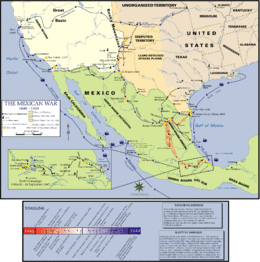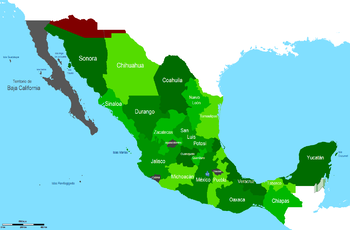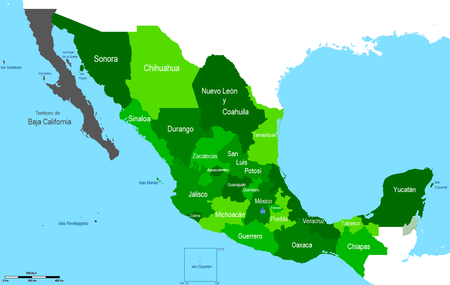جمهورية المكسيك الاتحادية الثانية
United Mexican States Estados Unidos Mexicanos | |||||||||||||||||||
|---|---|---|---|---|---|---|---|---|---|---|---|---|---|---|---|---|---|---|---|
| 1846–1863 | |||||||||||||||||||
الشعار الحادي: La Patria es Primero The Country is First | |||||||||||||||||||
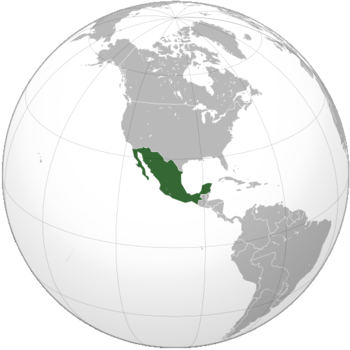 The United Mexican States in 1852, prior to the Gadsden Purchase. | |||||||||||||||||||
| العاصمة | Mexico City | ||||||||||||||||||
| اللغات المشتركة | Spanish (official), Nahuatl, Yucatec Maya, Mixtecan languages, Zapotec languages | ||||||||||||||||||
| الدين | Roman Catholicism | ||||||||||||||||||
| الحكومة | Federal presidential republic | ||||||||||||||||||
| President | |||||||||||||||||||
• 1846 | José Mariano Salas | ||||||||||||||||||
• 1858–1864 | Benito Juárez | ||||||||||||||||||
| Vice President | |||||||||||||||||||
• 1846–1847 | Valentín Gómez Farías | ||||||||||||||||||
| التشريع | Congress | ||||||||||||||||||
| Senate | |||||||||||||||||||
| Chamber of Deputies | |||||||||||||||||||
| التاريخ | |||||||||||||||||||
| 22 August 1846 | |||||||||||||||||||
| 1846–1848 | |||||||||||||||||||
| 2 February 1848 | |||||||||||||||||||
| 25 April 1854 | |||||||||||||||||||
| 5 February 1857 | |||||||||||||||||||
| 10 July 1863 | |||||||||||||||||||
• Maximilian I accepts the crown | 10 April 1864 | ||||||||||||||||||
| التعداد | |||||||||||||||||||
• 1852[1] | 7,661,919 | ||||||||||||||||||
• 1857[1] | 8,287,413 | ||||||||||||||||||
• 1864[1] | 8,629,982 | ||||||||||||||||||
| العملة | Mexican real | ||||||||||||||||||
| |||||||||||||||||||
| اليوم جزء من | Mexico United States | ||||||||||||||||||
The Second Federal Republic of Mexico (إسپانية: Segunda República Federal de México) is the name given to the second attempt to achieve a federalist government in Mexico after a period of centralism. Officially called the United Mexican States (Estados Unidos Mexicanos), a federal republic was established again on August 22, 1846 when interim president José Mariano Salas issued a decree restoring the 1824 constitution. The Second Republic continued to be rocked by the political instability that had characterized Mexico since independence. Mexico's loss in the war with the United States during this time saw half of Mexican territory become part of the United States. Even though Antonio López de Santa Anna played a major role in that loss, he returned to the presidency afterwards, selling further northern territory to the United States. The sale of the Mesilla Valley was for many the final straw, and liberals promulgated of the Plan of Ayutla in 1854, calling for the overthrow of Santa Anna. Santa Anna went into exile and the liberals set about implementing their vision of Mexico.
Liberals enacted a series of sweeping reforms, including a new federalist constitution, collectively known as the Liberal Reform, which then sparked a civil war, known as the War of the Reform, from 1857 to 1860. The conservatives lost the war, but the liberals' triumph however was soon interrupted by a French invasion in 1861, which gained collaboration from the recently defeated conservatives.
The French attempted to set up a client state known as the Second Mexican Empire. Conservatives invited Maximilian Habsburg to serve as monarch of the Empire. Mexican republicans nonetheless fought against the French invaders, lead by Benito Juárez's government in exile, which was backed by the United States. Ultimately the French were unable to consolidate control of the entire nation and under pressure from the United States which after the end of the Civil War, could more effectively enforce the Monroe Doctrine, withdrew from Mexico, leading to the Empire's collapse in 1867.
The period of the Second Republic following the end of the Second Empire, is known as the Restored Republic.[2][3]
التأسيس
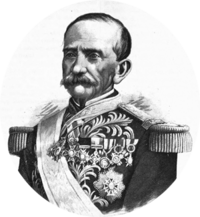
In the midst of war with the United States (1846–48), Mariano Paredes y Arrillaga staged a coup against the government of interim President José Joaquín de Herrera. Shortly afterwards, the Congress appointed him interim president; the vice presidency went to Nicolás Bravo.
On July 28, 1846 Mariano Paredes left the presidency to command the army in battle against the invaders from the United States, and vice president Bravo took office. On August 4 the federalists (headed by José Mariano Salas and Valentín Gómez Farías) led an uprising, causing the resignation of President Bravo. Mariano Salas took office as provisional president on August 6; on August 22, he reestablished the 1824 Constitution and called an election. With the constitution again in force, centralism ended and the federal system was restored.
Mexican–American War
The war between Mexico and the United States officially began on May 13, 1846 (when the United States Congress declared war on Mexico), but there had already been battles before that date. Mexico, in turn, declared war on the United States on May 23. After the declarations of war, US forces invaded Mexican territory in Tamaulipas, Nuevo León, Coahuila and Alta California, while at the same time blocking the ports of Tampico, Carmen, Guaymas, Mazatlan and San Blas (among others) and occupying Santa Fe, San Diego and Los Angeles.
The main US force (led by Zachary Taylor) continued through to the Rio Grande and into Mexico, defeating the forces of Pedro Ampudia in the Battle of Monterrey. On December 24, the Congress declared Antonio López de Santa Anna acting president and Valentín Gómez Farías vice president. Gómez Farías assumed the presidency in place of Santa Anna, who was fighting the US.
After the battles of Angostura, Padierna, Churubusco and Molino del Rey, the Castle of Chapultepec was defended by young cadets who became known as Niños Héroes ("boy heroes"). During the assault, the castle's commanders, generals (Mariano Monterde, director of the Military College of Mexico and Nicolas Bravowere), were taken prisoner. The fall of Chapultepec had two immediate consequences: the US occupation of Mexico City and the resignation of Santa Anna from the presidency on September 16, 1847.
Following the resignation of Santa Anna (and under the law of the time), Manuel de la Peña y Peña (president of the Supreme Court) assumed the office. On September 26 he established the seat of federal power in nearby Toluca and (soon afterwards) in Querétaro, where Congress convened. On November 11, De la Peña left office to serve as chancellor and negotiate peace with the United States Congress; General Pedro Maria Anaya was appointed substitute president. Anaya, refusing to satisfy the land claims of the United States, resigned on January 8, 1848. Manuel de la Pena y Pena was again named provisional president, and was dedicated to negotiating peace. On February 2 the Treaty of Guadalupe Hidalgo was signed, in which Mexico ceded 2،400،000 متر كيلومربع (930،000 sq mi) of northern territory. De la Peña was able to save for Mexico the Baja Peninsula and its union by land with Sonora and sovereignty over the Isthmus of Tehuantepec. Tehuantepec became increasingly of interest since it was a narrow point between the Gulf of Mexico and the Pacific Ocean, which could be a closer transit point than the Isthmus of Panama. The cash-strapped Juárez government in 1859 negotiated the McLane-Ocampo Treaty with the U.S., which would have given the U.S. considerable control over Tehuantepec. The treaty failed to take effect because the U.S. Senate did not ratify it.
Facing criticism for the signing of the treaties ending the Mexican–American War in 1848, De la Peña wrote:
He who would qualify the Treaty of Guadalupe as dishonorable by the extent of the ceded territory, can never understand the sorrows that cease by ending war ... The territories that have been ceded by the Treaty are not just lost for the sum of fifteen million pesos; but to regain our ports, the final cessation of all evil and of all sorts of horrors, and to comfort many families...[بحاجة لمصدر]
1848–1853
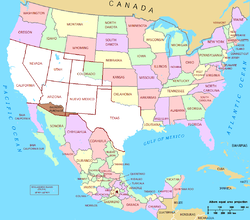
| Map of México from 1848 to 1853 | The territorial changes in the Republic were: | ||||||
|---|---|---|---|---|---|---|---|
|
Santa Anna dictatorship
Antonio Lopez de Santa Anna again assumed the presidency on April 20, 1853 at age 59. Two days after using his extraordinary-powers decree, the Rules for the Administration of the Republic were put into effect. These rules eliminated any control over the executive.
1857 constitution
After the fall of Santa Anna, Martin Carrera was named interim president by the military garrison of Mexico City on August 15, 1855. When Carrera resigned, Romulo Diaz de la Vega (military commander of the capital) took over as de facto president on September 12. On October 4, liberals under the Plan of Ayutla named John N. Álvarez interim president. The most important act of the Álvarez government was the convening of a Constituent Assembly to draft a new constitution that would replace the Constitution of 1824.
The Constituent Congress of 1856 convened amid a clerical uprising on February 18, 1856 with a speech by President Ignacio Comonfort (who had replaced Alvarez on December 11, 1855). Topics discussed were the attribution of powers, division of territory, individual rights and freedom of worship.
The Constituent Congress divided into two parties, the liberals and the conservatives. Among the liberals were former President Valentín Gómez Farías, Santos Degollado and Melchor Ocampo. Among the conservatives were Antonio Aguado, Mariano Arizcorreta and the governor of Durango, Marcelino Castañeda.
Impact
| Map of Mexico under the Constitution of 1857 | The 23 states of the federation were: | |||||||||||||||||||||||||||||||||||||||||||||||||||||||||||||||||||
|---|---|---|---|---|---|---|---|---|---|---|---|---|---|---|---|---|---|---|---|---|---|---|---|---|---|---|---|---|---|---|---|---|---|---|---|---|---|---|---|---|---|---|---|---|---|---|---|---|---|---|---|---|---|---|---|---|---|---|---|---|---|---|---|---|---|---|---|---|
Created the state of::
Are admitted as states:
|
حرب الإصلاح
Plan of Tacubaya
Beginning of the war (1857)
Parallel presidents
End of the Reform War (1861)

Foreign intervention
Napoleon III called Spain and the United Kingdom to a meeting in London to discuss a joint convention against the government of Mexico. On October 31, 1861, the three countries signed a document known as the London Convention, in which contained an agreement by the three powers to dispatch an expedition to Mexico to ensure the Mexican government repaid its debts.
Upon hearing the shocking news, the Congress reluctantly granted extraordinary powers to Juárez on December 11. When foreign ships arrived in Veracruz Juárez offered no resistance and allowed them to disembark at the port, seeking to resolve the conflict diplomatically. Foreign Minister Manuel Bent met with commissioners of the foreign powers; Spanish and British diplomats quickly came to an agreement upon realising the Mexicans were telling the truth concerning their poor economic situation. Both nations signed treaties with Mexico, and accepted the temporary suspension of payments along with peacefully withdrawing their forces. The French stayed on, intending to use the debt issue as an excuse to set up a puppet regime in Mexico under their control.
The interruption of the Republic
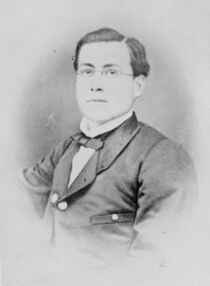
During 1862, battles between Mexico and the French continued. The battles of Dry Canyon and Cerro del Borrego followed the Battle of Puebla; both were French victories. After the arrival of reinforcements from France was the siege of Puebla, in which the city fell to the French on May 17, 1863. After the fall of Puebla, French troops went to Mexico City.
On May 31 Juárez and his cabinet left Mexico City and moved to San Luis Potosí and began his "errant government", which finally settled in Paso del Norte (now Ciudad Juárez). On June 1, 1863 garrison commander General Bruno Martinez issued a manifesto favoring French intervention in Mexico and recognizing Frédéric Forey as ultimate authority in the country. José Mariano Salas, former president of Mexico and restorer of the Federal Republic, took over Mexico City from June 1–10 (when French troops occupied the capital).
On June 16, General Forey decreed the formation of a Superior Board of Governors, which on June 24 named a triumvirate to take over the executive branch: Juan Nepomuceno Almonte, Jose Mariano Salas and Pelagius Antonio de Labastida (who, due to his absence, was temporarily replaced by John B. Ormachea).
On July 8, a 215 Notables Assembly was installed (in conjunction with the High Board of Government). On July 10, it established a monarchy and offered the crown of empire to Maximilian of Austria. This decree marked the end of the Second Federal Republic, beginning the Second Mexican Empire.
On July 11 the board consisted of Almonte, Salas, Labastida and the Regency of the Empire, which ruled until the arrival of Maximilian in Mexico. On October 3 at the Castle of Miramar, the Mexican delegation (headed by Jose Maria Gutierrez de Estrada, Juan Nepomuceno Almonte and Miguel Miramon Maximilian) was read the official request of Mexican monarchists for occupation of the throne of Mexico. Maximilian accepted the crown of the Mexican Empire, and arrived in Veracruz on May 28, 1864. He went to Mexico City with his wife Charlotte, where he was crowned on April 10, 1864 in the Metropolitan Cathedral.
Heads of state
In the nearly 17 years of the Second Federal Republic there were 14 presidents in 18 governments, of which only José Joaquín de Herrera completed his term. Herrera, Arista, Comonfort and Juárez were the only four constitutional presidents during this period (although two of them, Comonfort and Juárez, began their governments as interim presidents).
Interim President José Mariano Salas handed the presidency to vice president-elect Valentín Gómez Farías on December 23, 1846, who took office in place of Antonio López de Santa Anna (who was fighting the U.S. Army). On March 21, 1847, Santa Anna returned to Mexico and dismissed Gómez Farías, who went into exile. On April 1 Santa Anna had Congress set aside the vice presidency, and left the presidency to Pedro Maria Anaya on April 2.
Anaya gave the presidency back to Santa Anna on May 20, when he left to fight the U.S. Santa Anna resigned the presidency on September 16, and fled the capital when U.S. troops occupied Mexico City. Following the resignation of Santa Anna, Manuel de la Pena y Pena (president of the Supreme Court) became president.
De la Peña gave the presidency to Pedro Maria Anaya on November 13, when he left office to negotiate peace with the United States. Anaya resigned the presidency on January 8, 1848, refusing to cede territory to the United States, and de la Pena y Pena took office the same day. Concluding peace treaties with the United States, de la Peña called an election in which was elected José Joaquín de Herrera, who took office on June 2. Herrera concluded his term, and handed the presidency to President-elect Mariano Arista on January 15, 1851.
Arista resigned the presidency on January 5, 1853, when Congress denied him "extraordinary powers" to rule the country. On January 6, Juan Bautista Ceballos (president of the Supreme Court) assumed the presidency in place of Arista. Ceballos resigned on February 8; Manuel Maria Lombardini served as president de facto until April 20, when Lombardini granted to Santa Anna "extraordinary powers" to rule and handed the presidency over.
Santa Anna ruled as dictator until August 12, 1855, when he was overthrown by the Revolution of Ayutla. Martin Carrera, president since April 15, gave the charge to Romulo Diaz de la Vega on September 12. Diaz de la Vega left office on October 3; on October 4, Juan Álvarez became president. Alvarez, after calling the election of a constituent congress, handed the presidency to Ignacio Comonfort on December 11. Comonfort ruled as interim president until October 31, 1857, and from December 1 as president. After ignoring the Constitution of 1857 and supporting the Plan of Tacubaya, Comonfort ceased to be president December 17.
Under the Constitution the president of the Supreme Court, Benito Juárez, was acting president beginning on December 18; however, he did not set up his government until January 19, 1858 after being released from jail. Juárez was the constitutionally-elected president until July 18, 1872, keeping pace with presidents, presidents recognized by conservatives, the regency of the empire and Maximilian.
Since most of Juárez's rule was marked by civil wars and foreign invasions, he did not always have authority over much of Mexican territory. However, even during the Second Mexican Empire Juárez was recognized as President of Mexico by republican liberal forces and also importantly the United States. With the end of the American Civil War (1861–65), the U.S. gave material aid to the Juárez government to oust the French and their conservative Mexican supporters. Mexican republicans finally defeated the empire, and restored the republic. Juárez is recognized as president from December 18, 1857 to July 18, 1872.
Plan of Tacubaya – repudiation of the Constitution of 1857
The Plan of Tacubaya, which did not recognize the Constitution of 1857, originally recognized Ignacio Comonfort as president of Mexico. Comonfort was recognized by conservatives until January 11 of 1858, and resigned on January 21. Félix María Zuloaga was recognized as the conservative president on January 11; he formally assumed office on January 23, but was ousted by the Christmas Plan on December 24 and replaced by Manuel Robles Pezuela. Pezuela Robles remained conservative president until January 21, 1859; on January 24, Zuloaga resumed office. Zuloaga held a second term until February 2, when he was replaced by Miguel Miramón. Miramón (a conservative) left the presidency in the hands of José Ignacio Pavón on August 13, 1860—a position he held only two days, since Miramón resumed the presidency on August 15. Miramón ruled until December 24, having a rotating presidency with Zuloaga. Zuloaga, assisted by several military conservatives, became president of a conservative faction that was divided by internal conflicts and his term ended August 13. Despite being defeated by the liberals, the conservatives continued to recognize Zuloaga as president. On December 28, 1862, his term ended; by ending with a conservative government, this would prepare the way for what became the Second Mexican Empire.
Executive triumvirate
Before filing the change of government in the Federal Republic to a monarchy, a meeting of conservatives supported by the French army appointed a triumvirate to take on the executive duties of the country. This was composed of Juan Nepomuceno Almonte, José Mariano Salas and Pelagius Antonio de Labastida (and as interim, Juan Ormachea). This triumvirate ruled from June 24 to July 10, 1863, and from July 11 became the Regency of the Empire.
الهامش
- ^ أ ب ت Evolución de la Población de México durante los años de 1521 al 2000
- ^ Jan Bazant, "From Independence to the Liberal Republic, 1821-1867", Mexico Since Independence. Cambridge: Cambridge University Press 1991, pp. 42-47.
- ^ Friedrich Katz, "The Liberal Republic and the Porfiriato, 1867–1910" in Mexico Since Independence, Cambridge University Press 1991, pp. 49-65
- ^ "Constitución Federal de los Estados Unidos Mexicanos" (in الإسبانية).
- ^ "Portal Estado de Guerrero" (in الإسبانية).
- ^ "Portal Gobierno del Estado de Tlaxcala" (in الإسبانية). Archived from the original on 2009-12-27.
- ^ "Portal Ciudadano de Baja California" (in الإسبانية).
- ^ "el Comentario" (in الإسبانية). Archived from the original on 2010-08-10.
- ^ "Gobierno del Estado de Yucatán" (in الإسبانية). Archived from the original on 2010-04-11.
قالب:Former sovereign or unrecognized states within the United States
- CS1 الإسبانية-language sources (es)
- Pages using gadget WikiMiniAtlas
- Short description is different from Wikidata
- Articles containing إنگليزية-language text
- Pages using Lang-xx templates
- Articles containing إسپانية-language text
- Articles with unsourced statements from September 2012
- Articles with hatnote templates targeting a nonexistent page
- Pages using country topics with unknown parameters
- Coordinates on Wikidata
- المكسيك المستقلة
- Former territorial entities in North America
- جمهوريات سابقة
- عقد 1840 في المكسيك
- عقد 1850 في المكسيك
- عقد 1860 في المكسيك
- History of Mexico
- Political history of Mexico
- 1846 establishments in Mexico
- 1860s disestablishments in Mexico
- دول وأقاليم تأسست في 1846
- States and territories disestablished in 1863
- 19th century in Mexico
- 1863 disestablishments in Mexico
- Liberalism in Mexico


